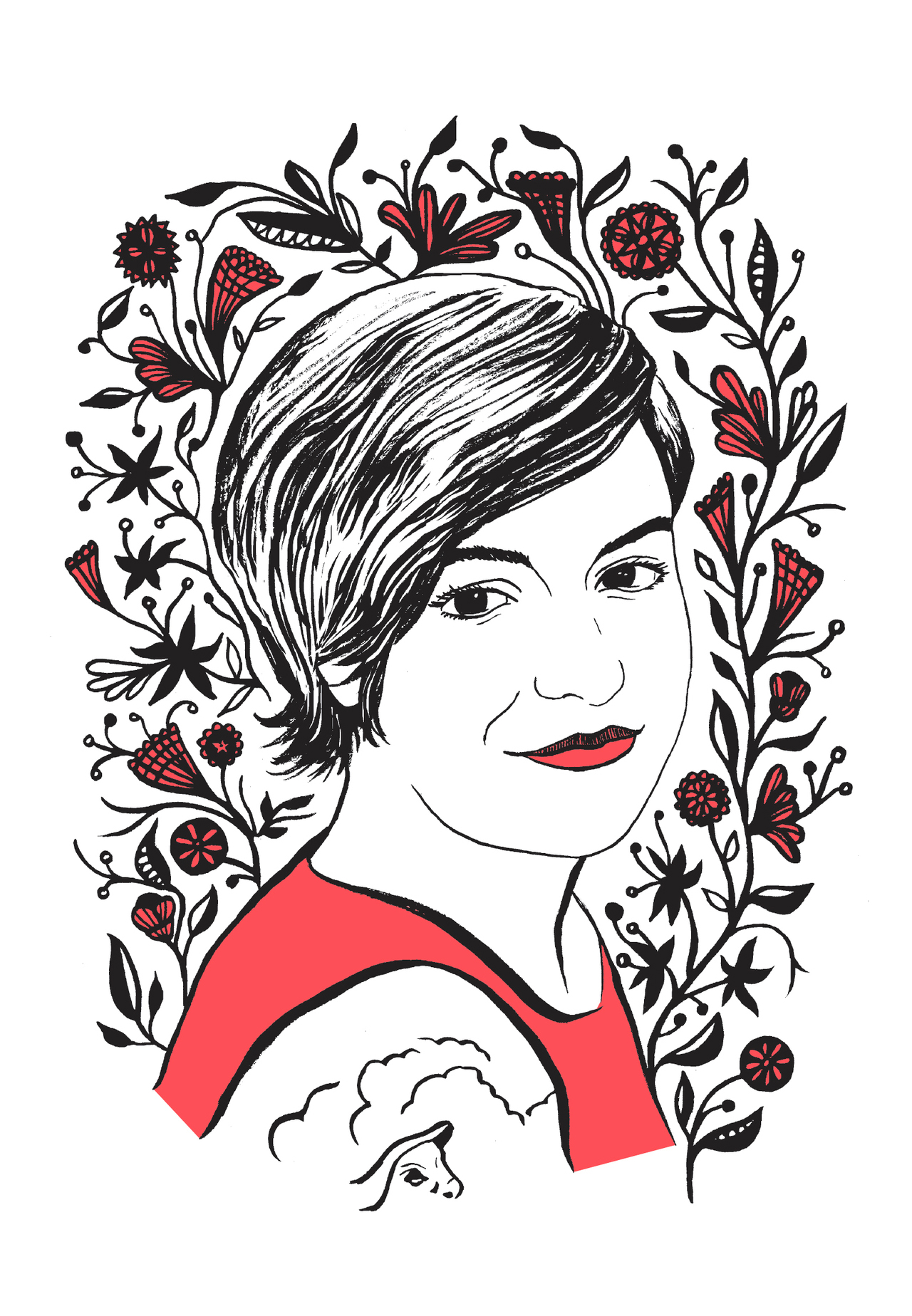

CHAPTER 28
LENA DUNHAM

Imperfect
I WAS IN A HOTEL ROOM, on a layover on my way to Paris, when I watched the premiere of Girls in the spring of 2012. This is the only remotely cool personal detail about me in relation to the hyper-cool Lena Dunham and her Emmy Award–winning HBO comedy series about four millennials who live in Brooklyn and stagger through the early years of independence. Lena’s cool quotient may fluctuate in relation to how people are feeling about her latest tweet; Instagram post; ill-considered political statement; tattoo acquisition; questionable red carpet outfit; degree of nudity; weight loss or gain, or recent magazine cover photograph. But there is one unhip horror of which she will never be accused: She is not a middle-aged woman.
I am old enough to be Lena Dunham’s mother. I even have a daughter who is currently the same age Hannah, Marnie, Jessa, and Shoshanna were in that first season when the nation was losing its mind over the hilariously self-involved, clueless eponymous girls—especially the perfectly terrible sex Hannah and Adam had on a broken-down couch that could have used its own condom. Weirdly, this makes me a much better appreciator of Girls than the girls for whom the show was created.*1
Because I came of age in the 1970s, and went to film school in the ’80s, I feasted on a cinematic diet of poorly lit European art films that revealed the occasional dense bush or flaccid penis (not to mention Bertolucci’s Last Tango in Paris, with the butter scene). I also sat through any number of student films starring the filmmakers’ normal-looking friends doing drugs and having bad sex—and thus my jaw didn’t drop when I watched Hannah, in that first episode, struggle to take off her tights on Adam’s couch. I thought she got it just right, and I laughed my head off, remembering. During that first short half-hour premiere, viewers were put on notice: Lena is a normal-looking person who’s going to show 20-something life in all its cringe-worthy glory.

MUCH HAS BEEN MADE ABOUT Lena Dunham’s privilege, as if the fact she was born to two celebrated, well-connected New York artists accounted for her drive and talent, or the ability to get a pilot green-lighted at HBO. For the daughter of photographer Laurie Simmons and painter Carroll Dunham, the main signifier of how Life Has Been Unfairly Good to Lena is the Tribeca loft in which she and her younger sister Grace grew up.*2 That loft, with its chic white walls and white floor, was one of the stars of Tiny Furniture, the $25,000 film Lena shot over the course of three weeks in 2009, which led eventually to her HBO deal for Girls. Success begetting success, she soon landed a three-plus-million-dollar book deal to write a collection of personal essays, published in 2014 as Not That Kind of Girl: A Young Woman Tells You What She’s Learned. Lena claimed to be inspired by Helen Gurley Brown’s 1982 best-selling self-help guide Having It All, but I didn’t see it. Really, it’s just an uneven collection of personal essays that might have been written by Hannah, had her Season 3 e-book deal panned out. Still, Lena took the money and wrote—and good for her.
Lena’s real advantages lay in having a close relationship with her mom and dad, and witnessing from a young age what it means to live a life in the arts. She was spared the learning curve that most of us go through, first being seduced by the romance of the creative life, which features much drinking, pot smoking, talking, and suffering before figuring out that it’s just like anything else: a beastly amount of hard work, long hours, late nights, boredom, and revision, revision, revision. “My parents taught me that you can have a creative approach to thinking that is almost scientific,” Lena observed. “You don’t have to be at the mercy of the muse. You need your own internalized thinking process that you can perform again and again.”
On screen, as Hannah Horvath, Lena Dunham is not so savvy. Actually, she’s whatever’s the opposite of savvy, with her endless chattering, self-absorption, lack of self-awareness, and—cardinal sin—being unlikable. Because viewers apparently have trouble distinguishing between Hannah the character and Lena the creator, Lena has been branded as unlikable as well. The main thing viewers struggled with was that Hannah had a normal, slightly chubby body, and still insisted on being naked. She dared to be, week after week, season after season, a young woman okay in her less-than-perfect body.
It’s ridiculous that this was the primary act that made Lena Dunham difficult—that what was seen as either appalling or “brave” was being naked while not being a supermodel. On Instagram she wrote: “Let’s get something straight: I didn’t hate what I looked like—I hated the culture that was telling me to hate it. When my career started, some people celebrated my look but always through the lens of ‘isn’t she brave? Isn’t it such a bold move to show THAT body on TV?’ ”
Maybe people simply confused courage with confidence. As a creator, Lena was confident that her imperfect body would hold your attention—so confident that even if she, as a director, shot herself at unflattering angles doing unflattering things, you’d be unable to look away. Once, when asked when she felt the most sexy, she answered without hesitation: “When I’m directing.” That’s a difficult woman talking right there. She claims her power in her actions, not in the perceptions of others.
For my middle-aged white woman money, Lena Dunham’s genuine act of bravery rested in the compassionate portrayal of Hannah’s parents. Loreen (Becky Ann Baker) and Tad (Peter Scolari) are academics in their late 50s who teach, presumably, at Michigan State in East Lansing. They are also actual humans with their own struggles, desires, and secrets. Even though the show is not about them, they serve as more than props, punch lines, or cautionary tales of what will happen to the main character if she doesn’t follow her dream/embrace her passion/take the teaching job in France/say no to the boring, yet safe, boyfriend/dare to age.
This isn’t to say there’s a dearth of well-rounded, compelling middle-aged characters on TV. But they always find themselves in what I think of as Eileen Fisher television—shows that are well made and stylish, with no expectation that anyone under 45 will tune in.*3
In Season 1, Episode 6 of Girls, Hannah goes home to East Lansing for a weekend with her parents. While she goes off to a sad party with Eric, the cute pharmacist she’d met earlier in the day when she’d picked up Loreen’s prescription (which we assume is hormone replacement related), Loreen and Tad celebrate their anniversary with a nice dinner out and shower sex.
“Wet and wild!” exclaims Tad. Loreen moans as her boobs slap about. But the evening proves to be too much crazy for Tad. Between the heavy meal out, the booze, the frisky sex, the hot water, he passes out, slips, and falls. Hannah walks in the door after her own awful one-night stand with Eric the pharmacist only to hear her mom yelling in distress. She bursts into the bathroom to see her dad passed out. He’s naked, and her mom is naked. It’s the first time we see Hannah assess the situation quickly and take charge, helping to cover her dad and move him to the bedroom. There’s more to the story of Loreen and Tad—no spoilers here. But kudos to Lena for making them complex characters—and for also giving them the full cringe-worthy Girls treatment, including awkward nudity.
In 2015, while Girls was heading into the final stretch of its run (the final season aired in 2017), Lena and her friend Jennifer Konner started Lenny, a weekly newsletter for young (and not so young) feminists. When I signed up I thought, Leave it to Lena Dunham to make newsletters cool again. Her provocative Tweet storm–inducing pieces include “Supporting Reproductive Rights When You’re a Person of Faith”; “One of a Kind: On the Healing Power of Sexual Fantasy”; and “The All-American Menstrual Hut.” She’s also been vocal about her fight for birth control rights, which includes the care she receives for her own complicated and ongoing personal battle with endometriosis (she posted a picture of herself in the hospital getting treatment after a horrific episode following the Met Gala).
This determined outspokenness has made Lena one of those women about whom people say “Why won’t she just go away?” And it’s to her credit that she has no intention of shutting up in order to make people like her. Full disclosure: I also find her annoying at times. She’s a difficult woman, and sometimes difficult women grate on our last nerve. But here’s a radical notion: That’s okay.
The cries of outrage over her remark that she wished she’d had an abortion to better empathize with women who’d undergone the procedure could be heard in outer space. Should she have said it? No. Has any man on the planet ever said something stupid and been forgiven within the time it has taken me to write this sentence? You know the answer.
Recently, I watched Lena on 73 Questions, the vogue.com video series where a guy with a camera follows you around while shooting off intimate queries. Lena wore a striped tank top, hip-slung jeans, and high heels. She appeared cute, smart—not perfect but perfectly acceptable. It’s a measure of how difficult she is that I didn’t worry, seeing her this way, that her unruly self was going to be sucked into the celebrity machine, where she would be turned into a likable size 2 star who wears the right message T-shirts but otherwise doesn’t rock the boat. Lena is far too difficult for that.
*1Somewhat icky factoid: Twenty-two percent of viewers during that first season were men over 50. I’ll leave you to make of that what you will.
*2That her mother bought the place, housed inside a former textile warehouse, back in the ’70s when Tribeca was still sketchy, before the invasion of J.Crew, is overlooked.
*3Grace and Frankie, starring Lily Tomlin and Jane Fonda, comes readily to mind, as well as any other show featuring women over 50 who fail to still look fetching in a sleeveless sheath, à la Julia Louis-Dreyfus in Veep. (I’m not upper arm–shaming Lily and Jane, I promise.)